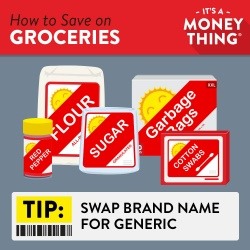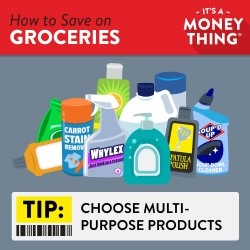
Picture this scenario: you’re steering your shopping cart through the sliding doors of the supermarket, shopping list in hand. As you walk the aisles, there’s a strategy you can use to save an average of 33% on your entire purchase. It doesn’t require any coupon cutting or signing up for rewards cards. And the best part? You still get every single item on your list. The secret? Buying private-label products instead of brand-name products.
 What are private-label products?
What are private-label products?
Commonly referred to as “store brand” or “generics,” private-label products are manufactured by a supplier and offered under another retailer’s brand. Some suppliers exclusively offer store-brand products, while others are brand-name manufacturers who use their facility to also create value-brand products in a non-competitive category (a brand-name ketchup producer may also manufacture a store-brand tomato paste, for example). In some cases, a single supplier may provide products (with different recipes and formulas) for a number of different store brands.
Why are they so much cheaper?
Private labels are able to sell their product for less because their marketing and advertising costs are significantly lower than their brand-name counterparts (when’s the last time you saw a Super Bowl commercial for no-name tortilla chips?) and they’re able to pass those savings along to the customer. Interestingly, even though they’re priced more cheaply, store brands usually provide the supermarket with a higher profit margin than brand names do. So, not only are generics a good deal for you—they’re also a pretty good deal for the store’s bottom line!
What about the difference in quality?
One of the biggest obstacles in switching over to a store brand is a psychological one: getting over the idea that a brand name automatically means top quality. We’ve all had the experience of being disappointed after straying from a brand-name product—but by convincing yourself that all off-brand products are low quality, you’re missing out on some great deals, as well as some great products. In a Consumer Reports taste test, more than 60% of store-brand items were judged as good as or better tasting than the national brand-name items.
In recent years, retailers have been doing their part to make store brands more appealing to shoppers by updating their branding and packaging designs, and by including exciting specialty products in their store-brand lineup. Some grocery stores, including Target and Trader Joe’s, have managed to build extreme brand loyalty to their store-brand products.
Here are a few strategies to start incorporating more private-label products into your shopping list.
 Single ingredient? No-brainer.
Single ingredient? No-brainer.
When something on your list has a single ingredient, it’s hard to justify paying more for a brand name (salt is salt; bleach is bleach). The same applies to simple pantry items such as flour, sugar and spices. For produce, learn to read the signs for freshness before defaulting to the label. Other kitchen cupboard staples such as nuts, dried fruits and canned foods are also interchangeable for the most part (although it’s always a good idea to check the ingredients list to see if there are any differences in preservatives or additives that might affect your decision).
Play with preference
Take a peek inside your fridge and pantry and take note of the products you consistently buy brand name. Is there a reason why you’ve never strayed from them? Do you have a real preference for the taste, or are you buying them simply because that’s what you grew up with? Substituting the occasional brand-name stock, seasoning or sauce with a store brand can be a great way to save money while exploring new flavor profiles.
 Be selective about your brand loyalty
Be selective about your brand loyalty
Sure, sometimes a brand-name product will outperform its generic version—but before you automatically reach for the national brand, think about whether that performance is really worth the extra expense. You will find that some items in your shopping cart are completely non-negotiable, whereas others have more relaxed requirements. For example, shelling out for brand-name super-soft tissues with lotion might mean the world to someone who suffers through allergy season, but for the occasional nose-blower, a store-brand box of tissues will do the trick. Be critical and selective about which specific products deserve your brand loyalty.
Trial and error
We tend to be creatures of habit; as a result, it can be difficult to introduce change into our routines. Not every generic product you try will be a winner, but that doesn’t mean that there aren’t any generic winners out there! Instead of overhauling your entire shopping list all at once, try swapping out one or two products every time you go to the store and see what works for you. Over time, you’ll be able to keep your household running while saving some cash at the same time.

Was this information useful? Visit our It's A Money Thing home page for more quick videos and helpful articles to help you make sense of your money, one topic at a time! Check back, new topics will be introduced regularly.






 What are private-label products?
What are private-label products? Single ingredient? No-brainer.
Single ingredient? No-brainer. Be selective about your brand loyalty
Be selective about your brand loyalty


